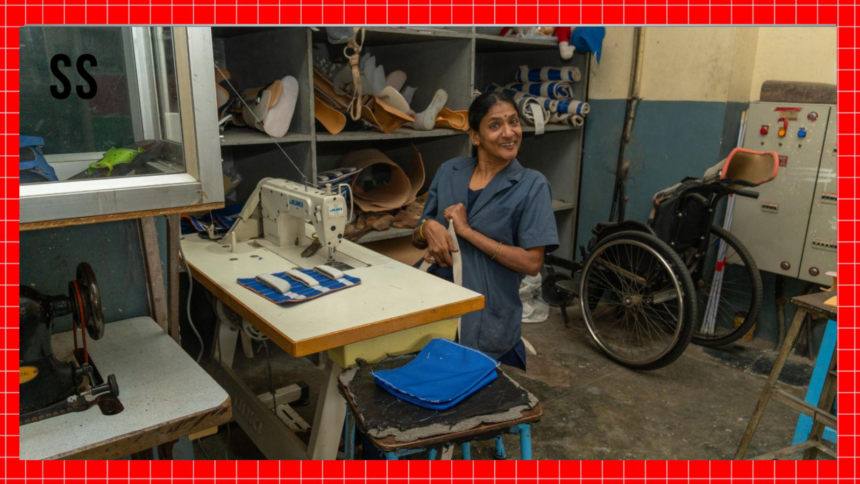Main Points In Hindi (मुख्य बातें – हिंदी में)
-
सहायक प्रौद्योगिकी की आवश्यकता: विश्व की बढ़ती जनसंख्या के साथ, यूनिसेफ और डब्ल्यूएचओ की 2019 की रिपोर्ट के अनुसार, लगभग 2.5 बिलियन लोगों को स्वतंत्र जीवन जीने के लिए सहायक उत्पादों की आवश्यकता है, जो 2050 तक 3.5 बिलियन तक बढ़ने की संभावना है।
-
भारत में पहुंच की कमी: भारत में सहायक प्रौद्योगिकी तक पहुंच बहुत कम है, कुछ क्षेत्रों में केवल 3% से भी कम लोगों के पास सहायक उपकरण हैं, जबकि विकलांग व्यक्तियों में केवल 29% के पास ही सहायक उपकरण उपलब्ध हैं।
-
सरकारी प्रयास और योजनाएं: भारत सरकार ने सहायक उपकरणों की उपलब्धता बढ़ाने के लिए कई पहलें की हैं, जैसे कि एडीआईपी योजना, जो विकलांग व्यक्तियों को व्हीलचेयर, प्रोस्थेटिक्स, और श्रवण उपकरण प्रदान करती है।
-
स्थानीय विनिर्माण का महत्व: स्थानीय स्तर पर सहायक उपकरणों का निर्माण करने से लागत कम होती है और अधिक लोगों को इनका लाभ प्राप्त होता है। उदाहरण के लिए, दृष्टिहीन लोगों के लिए किफायती स्मार्ट चश्मे और अनुकूलित व्हीलचेयर का विकास किया गया है।
- चुनौतियाँ और जागरूकता की आवश्यकता: सहायक प्रौद्योगिकी की उपलब्धता और इसके लाभों के बारे में जागरूकता की कमी है, विशेष रूप से ग्रामीण क्षेत्रों में। एक समग्र राष्ट्रीय रणनीति की आवश्यकता है ताकि विकलांग व्यक्तियों को अधिकतम समर्थन और संसाधनों का लाभ मिल सके।
Main Points In English(मुख्य बातें – अंग्रेज़ी में)
Here are the main points from the provided text regarding the growing need for assistive technology globally and its challenges and developments in India:
-
Increasing Global Demand: A UNICEF and WHO report in 2019 indicated that about 2.5 billion people worldwide require assistive products for independent living, a figure projected to rise to 3.5 billion by 2050, marking accessibility as a global priority.
-
Access Challenges in India: In India, the access rate to assistive technology is alarmingly low, with only 29% of people with disabilities possessing assistive devices. Some regions report access rates below 3%, highlighting a severe gap in unmet needs.
-
Government Initiatives: The Indian government is taking significant steps to make assistive technology more affordable and accessible, such as the Assistance for Disabled Persons for Purchasing/Fitting of Aids and Appliances (ADIP) scheme, which has been operational since 1981, providing essential devices like wheelchairs and prosthetics.
-
Local Manufacturing and Innovations: Local manufacturing is crucial for meeting the needs of millions who lack access to assistive technologies. Innovations, such as cost-effective smart glasses for the visually impaired and customized prosthetics, demonstrate India’s ability to develop affordable and high-quality solutions tailored to local needs.
- Ongoing Challenges and Awareness: Despite advancements, challenges persist, including a lack of awareness about the availability of assistive technology and underdeveloped distribution networks, particularly in rural areas. A cohesive national strategy is required to enhance accessibility and ensure that no one is left behind.
These points encapsulate the urgent need for assistive technology and the focused efforts being made to improve access and affordability in India.


Complete News In Hindi(पूरी खबर – हिंदी में)
विश्व को सहायक प्रौद्योगिकी की बढ़ती आवश्यकता का सामना करना पड़ रहा है। यूनिसेफ और डब्ल्यूएचओ की 2019 की रिपोर्ट के अनुसार, लगभग 2.5 बिलियन लोगों को स्वतंत्र जीवन जीने के लिए सहायक उत्पादों की आवश्यकता होती है। 2050 तक यह आंकड़ा 3.5 बिलियन तक बढ़ने का अनुमान है, जिससे पहुंच एक वैश्विक प्राथमिकता बन जाएगी।
फिर भी, भारत में, सहायक प्रौद्योगिकी तक पहुंच चिंताजनक रूप से कम है, कुछ क्षेत्रों में इसकी दर 3% से भी कम है। केवल 29% विकलांग लोगों के पास सहायक उपकरण हैं, अधूरी मांग एक गंभीर चुनौती को उजागर करती है।
फिर भी, इन चुनौतियों के बीच, भारत सहायक प्रौद्योगिकी को अधिक किफायती और सुलभ बनाने के लिए महत्वपूर्ण कदम उठा रहा है, जिससे लाखों लोगों के जीवन में बदलाव आ रहा है।
विकलांग व्यक्तियों को सहायक उपकरणों/उपकरणों की खरीद/फिटिंग के लिए सहायता (एडीआईपी) योजना जैसी सरकारी पहलों ने इस अंतर को पाटने में महत्वपूर्ण भूमिका निभाई है। 1981 से संचालित, इस योजना ने व्हीलचेयर, प्रोस्थेटिक्स और श्रवण उपकरणों जैसी आवश्यक सहायता वितरित की है, जिसमें श्रवण बाधित बच्चों के लिए कर्णावत प्रत्यारोपण भी शामिल है।
इसी तरह, 2015 में शुरू किए गए सुगम्य भारत अभियान (सुगम्य भारत अभियान) ने बुनियादी ढांचे, परिवहन और सूचना प्रणालियों में पहुंच को संबोधित करके बाधा मुक्त वातावरण बनाने पर ध्यान केंद्रित किया है। ये प्रयास अधिक समावेशी भारत के निर्माण के लिए सरकार की प्रतिबद्धता को रेखांकित करते हैं।
हालाँकि, सहायक प्रौद्योगिकी का स्थानीय विनिर्माण उन लाखों लोगों की जरूरतों को पूरा करने में महत्वपूर्ण भूमिका निभा सकता है, जिनकी उन तक पहुंच नहीं है। भारत की औद्योगिक क्षमता और लागत प्रभावी नवाचार पर फोकस ने इसकी आबादी की अनूठी जरूरतों के अनुरूप किफायती, उच्च गुणवत्ता वाले समाधानों का मार्ग प्रशस्त किया है।
उदाहरण के लिए, दृष्टिबाधित लोगों के लिए 20,000 रुपये से कम कीमत वाले स्मार्ट चश्मे का विकास, नवप्रवर्तन के साथ सामर्थ्य को संयोजित करने की भारत की क्षमता को दर्शाता है। स्थानीय रूप से निर्मित ऑल-टेरेन व्हीलचेयर और ऊबड़-खाबड़ भारतीय इलाकों के लिए डिज़ाइन किए गए कस्टमाइज्ड प्रोस्थेटिक्स उन हजारों लोगों के लिए गतिशीलता को वास्तविकता बना रहे हैं जिनके पास पहले कोई विकल्प नहीं था।
एक किसान की कहानी पर विचार करें, जिसने रीढ़ की हड्डी की चोट के बाद, स्थानीय रूप से निर्मित घुटने-टखने-पैर ऑर्थोसिस (केएएफओ) की मदद से अपनी आजीविका वापस पा ली। इस उपकरण ने उन्हें कोहनी की बैसाखी के सहारे चलने और स्वतंत्र रूप से अपने कृषि कार्य का प्रबंधन करने में सक्षम बनाया।
दूसरा उदाहरण एक पैराप्लेजिक पेशेवर का है, जिसकी अनुकूलित व्हीलचेयर, भारत में डिज़ाइन और निर्मित की गई, ने न केवल उसे काम पर आने-जाने की अनुमति दी, बल्कि उसे अपने करियर की आकांक्षाओं को प्राप्त करने के लिए सशक्त भी बनाया। ये अलग-अलग मामले नहीं हैं; वे एक बढ़ते आंदोलन का प्रतिनिधित्व करते हैं जहां किफायती सहायक उपकरण व्यक्तियों को स्वतंत्र, सम्मानजनक जीवन जीने में सक्षम बना रहे हैं।
स्थानीय विनिर्माण कम लागत के अलावा और भी बहुत कुछ करता है। यह नौकरियाँ पैदा करके, घरेलू उद्योग को बढ़ावा देकर और सरकार की “मेक इन इंडिया” पहल के अनुरूप नवाचार को बढ़ावा देकर आर्थिक विकास को बढ़ावा देता है।
यह दृष्टिकोण सुनिश्चित करता है कि विकसित समाधान भारत की आबादी की विविध आवश्यकताओं को संबोधित करते हुए प्रासंगिक रूप से प्रासंगिक हैं। सेरेब्रल पाल्सी चेयर और टॉयलेट एक्सेसिबिलिटी सिस्टम जैसे नवाचार स्थानीय चुनौतियों की गहरी समझ को दर्शाते हैं, जो व्यावहारिक, किफायती समाधान पेश करते हैं जो वास्तव में जीवन बदल देते हैं।
इन प्रगतियों के बावजूद चुनौतियाँ कायम हैं। कई क्षेत्रों में अभी भी सहायक प्रौद्योगिकी की उपलब्धता और लाभों के बारे में पर्याप्त जागरूकता का अभाव है।
सहायक उपकरणों के वितरण नेटवर्क, विशेष रूप से ग्रामीण क्षेत्रों में, अविकसित हैं, जिससे सबसे किफायती समाधानों की पहुंच भी सीमित हो गई है। ये मुद्दे एक सामंजस्यपूर्ण राष्ट्रीय रणनीति की तत्काल आवश्यकता पर प्रकाश डालते हैं। देशव्यापी पहुंच लेखापरीक्षा कमियों की पहचान करने और संसाधनों को वहां निर्देशित करने में एक महत्वपूर्ण कदम हो सकता है जहां उनकी सबसे अधिक आवश्यकता है, यह सुनिश्चित करते हुए कि कोई भी व्यक्ति पीछे न छूटे।
सहायक प्रौद्योगिकी को किफायती और सुलभ बनाने की दिशा में भारत की यात्रा प्रगति, नवाचार और लचीलेपन की कहानी है। स्थानीय विनिर्माण को प्राथमिकता देकर और नीतियों को अपने लोगों की जरूरतों के साथ जोड़कर, देश न केवल जीवन बदल रहा है बल्कि दुनिया के लिए एक उदाहरण भी स्थापित कर रहा है।
निरंतर प्रयासों और समान वितरण पर ध्यान देने के साथ, भारत में सहायक प्रौद्योगिकी में वैश्विक आंदोलन का नेतृत्व करने, जीवन में बदलाव लाने और लाखों लोगों को अधिक स्वतंत्रता और अवसर के साथ जीने में सक्षम बनाने की क्षमता है।
(डॉ. सेंथिल एनएस कुमार एसोसिएशन ऑफ पीपल विद डिसएबिलिटी (एपीडी) के सीईओ हैं)
(अस्वीकरण: इस लेख में व्यक्त विचार और राय लेखक के हैं और जरूरी नहीं कि ये योरस्टोरी के विचारों को प्रतिबिंबित करें।)
Complete News In English(पूरी खबर – अंग्रेज़ी में)
Certainly! Here’s a simplified version of the provided content:


The world is facing an increasing need for assistive technology. According to a report from UNICEF and WHO in 2019, around 2.5 billion people need assistive products to live independently, and this number is expected to rise to 3.5 billion by 2050, making accessibility a global priority.
However, in India, access to assistive technology is alarmingly low, with some regions seeing availability rates of less than 3%. Only 29% of people with disabilities in India own assistive devices, revealing a significant unmet need.
Despite these challenges, India is making important strides to make assistive technology more affordable and accessible, positively impacting millions of lives. Government initiatives, such as the Assistive Devices Distribution Programme (ADIP), which has been running since 1981, have played a key role in providing essential aids like wheelchairs and prosthetics.
Additionally, the Accessible India Campaign, launched in 2015, focuses on creating an environment free from barriers by addressing accessibility in infrastructure, transportation, and information systems. This highlights the government’s commitment to building a more inclusive society.
Local manufacturing of assistive technology is pivotal for meeting the needs of millions who currently lack access. With India’s industrial capabilities and focus on cost-effective innovations, affordable, high-quality solutions are being developed to suit the unique needs of its population.
For instance, the creation of smart glasses costing less than ₹20,000 for visually impaired individuals showcases India’s capacity to combine innovation with affordability. Similarly, locally produced all-terrain wheelchairs and customized prosthetics designed for rugged Indian terrain are enabling mobility for many who previously had no options.
There are inspiring stories, like that of a farmer who regained his livelihood after a spinal injury, thanks to a locally made knee-ankle-foot orthosis. Another example is a paraplegic professional who can now commute to work with a custom-designed wheelchair made in India, empowering him to achieve his career goals. These cases reflect a growing movement where affordable assistive devices are enabling individuals to lead independent and dignified lives.
Local manufacturing does more than reduce costs; it also creates jobs, supports local industries, and encourages innovation in line with the "Make in India" initiative. By prioritizing local solutions, India ensures that the advancements are relevant to its diverse population, addressing local challenges with practical, affordable innovations that can significantly change lives.
Nevertheless, challenges remain, including a lack of awareness about the availability and benefits of assistive technology in many areas, particularly rural regions where availability is still limited. This calls for a cohesive national strategy to identify gaps and ensure resources are directed where they are most needed, ensuring no one is left behind.
India’s journey to make assistive technology affordable and accessible is a story of progress, innovation, and resilience. By prioritizing local production and aligning policies with the needs of its people, India is changing lives and setting an example for the world.
With ongoing efforts and a focus on equitable distribution, India has the potential to lead a global movement in assistive technology, transforming lives and enabling millions to live with more independence and opportunities.
(Dr. Senthil N.S. Kumar is the CEO of the Association of People with Disabilities (APD). The views expressed are his own and do not necessarily reflect those of YourStory.)
This version conveys the main ideas in a more straightforward manner.




